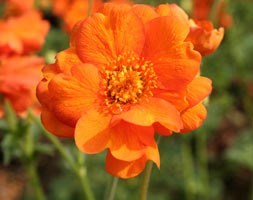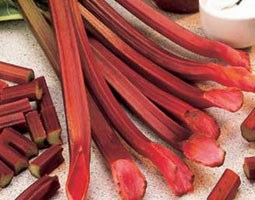New products at Crocus
by Sarah - December 22nd, 2013.Filed under: Crocus, New Products.
Crocus just added these new products
Geum ‘Prinses Juliana’ (avens) £5.99
Position: full sun or partial shade Soil: fertile, moist but well-drained soil Rate of growth: fast Flowering period: June to September Hardiness: fully hardy A stunning variety of avens with fiery orange flowers from June to September, held on wiry stems above pretty hummocks of puckered, foliage. This easy-to-grow geum looks at its best among other ‘hot’ coloured flowers towards the front of well-drained border in sun or partial shade. Garden care: Lift and divide large clumps every year in early spring or late autumn.
rhubarb ‘Champagne’ (rhubarb Champagne crowns) £3.99
Position: full sun Soil: any, except waterlogged soils Rate of growth: average Other features: the leaves may cause severe discomfort if ingested; the scarlet leaf stalks are excellent for making pies, jams and wine Hardiness: fully hardy Long, scarlet stems that have a deliciously sweet taste. Though an old variety, it is easy to grow, reliable and early. Perfect for fertile, well-drained areas of the vegetable garden or allotment, once planted it should not be moved and appreciates a generous annual mulch of well-rotted compost or manure. Garden care: Rhubarb crowns (or sets) are sent out in a packet containing a little compost or peat, but are generally considered as ‘bare root’. They will just look like a section of root, but as soon as they arrive they should be unpacked and planted out within a few days. Potted rhubarb can be planted out at any time of the year provided the ground is not frozen. Rhubarb needs an open, sunny spot with fertile, moist but freely-draining soil. Heavy soils should be avoided as overly-wet conditions in winter may rot the crowns. Rhubarb does need a cold period before it will start to put on new growth in spring, however hard frosts may damage the newly emerging growth, so try not to plant in a frost pocket if you can. Prepare the bed well by removing weeds and digging in composted manure, and plant the crowns at intervals of 75cm – 1m, making sure the dormant buds are just below the surface of the soil. Keep well watered and in spring apply a dressing of composted manure, making sure you avoid covering the crown of the plant. Sulphate of ammonia can be applied in summer. It is important that the stalks are not harvested in their first year as this will adversely affect the plants vigour, but cut any old, yellow leaves off after they have faded and remove all the leaves after they have died back in autumn. You should also remove any flowering stalks which appear. In the second year, you may start to harvest some of the stems, but restrict yourself to between a third and a half of the total crop, leaving the rest to mature on the plant. In subsequent years, stems can be harvested from late spring up until mid to late summer, although the stems tend to become tougher and less tatsy towards the end of the season. Allowing some late-developing stems to develop fully will also help the plant generate more energy for the following years crop. If you want an early (usual








